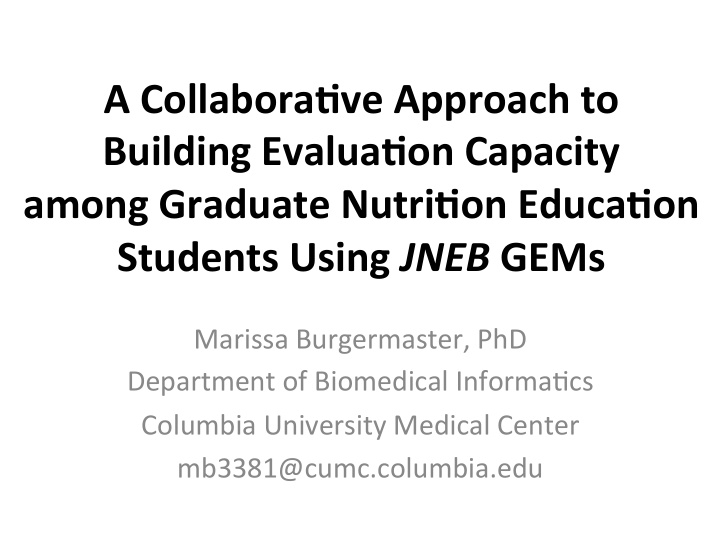



A Collabora)ve Approach to Building Evalua)on Capacity among Graduate Nutri)on Educa)on Students Using JNEB GEMs Marissa Burgermaster, PhD Department of Biomedical Informa9cs Columbia University Medical Center mb3381@cumc.columbia.edu
How does “evalua9on” make you feel?
schools improvements summary improve judge nutrition grade process list scale done effective refine effectiveness assessment curriculum test criticism results testing comparison education assess recommendations determine get question nervous rigor just impact study survey progress
“Just get it done.”
Why do we have evaluphobia ? • Past experiences, especially during schooling or in the workplace • Emphasis on mature programs and rigorous causal designs in university seNngs
Resource-intensive evalua9ons are not always appropriate for programs delivered by entry-level nutri9on educators. Urban, J. B., Hargraves, M., & Trochim, W. M. (2014). Evolu9onary evalua9on: Implica9ons for evaluators, researchers, prac99oners, funders and the evidence-based program mandate. Evalua&on and program planning , 45 , 127-139.
Can learning more about evalua9on improve aNtudes and self-efficacy? • 90-minute evalua9on seminar + readings • Applying knowledge in a collabora9ve ac9vity
Lecture + readings • Value of evalua9on in nutri9on educa9on • Appropriate evalua9on by program stage • Types of evalua9on • Strategies for integra9ng context and par9cipant voices in evalua9on
Collabora9ve ac9vity 1. Each group of 3-4 students was presented with a “Great Educa9onal Material” from JNEB with the evalua9on sec9on hidden under a flap. 2. Based on program descrip9on, groups planned how they would evaluate the program. 3. Groups compared their approach and the published evalua9on. 4. Groups shared their program, evalua9on, and comparison with the class.
Learning about evalua9on improved aNtudes and self-efficacy. 5 4 3 Baseline Post 2 1 0 aNtude self-efficacy
Do you consider yourself an evaluator? Pre Post Yes Yes No No
Acknowledgements This study was conducted at Special thanks to: Teachers College Columbia Isobel Contento University and was Jennifer Brown Urban designated exempt by the Thomas Archibald Teachers College IRB. William Trochim Monica Hargraves Virginia Carraway-Stage Scof Perez-Fox of Starship Designs (www.strshp.com)
Evaluating Nutrition Education Marissa Burgermaster Objectives Students will be able to: • Articulate the value of program evaluation in the field of nutrition education • Describe the benefits and drawbacks of using a heirarchy of evidence • Suggest appropriate evaluation designs for different programs • Compare and contrast formative, process, and outcome evaluation • Analyze how implementation and contextual factors can be integrated in an evaluation • Identify strategies for including participant voices in evaluation • Apply principles from “evolutionary evaluation” and “comprehesive approach to process evaluation” in their own nutrition education projects Readings Graig, E. (2014). Why evaluate? Usable Knowledge. www.usablellc.net Academy of Nutrition and Dietetics (2012). Which type of study is preferred? Evidence Analysis Manual . Chicago, IL: Academy of Nutrition and Dietetics, pp. 30-32. Archibald, T. (2015). “They just know”: The epistemological politics of “evidence-based” non-formal education. EPP, 48 , 137-148. Chen, H.T. (2010). The bottom up approach to integrative validity: A new perspective for program evaluation. EPP, 33 , 205-214. Urban, J.B., Hargraves, M. & Trochim, W.M. (2014). Evolutionary evaluation: Implications for evaluators, researchers, practitioners, funders and the evidence-based practice mandate. EPP, 45 , 127-139 Durlak, J. & DuPre, E. (2008). Implementation matters: A review of research on the influence of implementation on program outcomes and the factors affecting implementation. AJCP, 41 , 327-350. Steckler, A. et al. (2003). Pathways process evaluation results: A school-based prevention trial to promote healthful diet and physical activity in American Indian third, fourth, and fifth grade students. Preventive Medicine, 37 , S80-90. Singh, A.S., Chinapaw, M.J.M., Brug, J., & van Mechelen, W. (2009). Process evaluation of a school-based weight gain prevention program: the Dutch Obesity Intervention in Teenagers (DOiT). HER, 24 (5), 772-222 Baranowski, T. & Jago, R. (2005) Understanding the mechanisms of change in children’s physical activity programs. Exercise and Sport Science Reviews, 33 (4), 163-168. Gray, H.L., Contento, I.R., Koch, P. (2015). Linking implementation process to intervention outcomes in a middle school obesity prevention curriculum, ‘Choice, Control and Change.’ HER. Greaney, M. et al. (2014). Implementing a multicomponent school-based obesity prevention intervention: A qualitative study. JNEB, 46 (6), 576-581. Burgermaster, M., Contento, I., Gray, H. L., & Koch, P. (2015). Food, Health & Choices: A comprehensive approach to process evaluation for childhood obesity prevention trials. JNEB, 47 (4), S77. Key questions: • Why evaluate? • What are the various connotations of the word, “evaluation”? How does evaluation make people feel? Why is this important to acknowledge? • How should nutrition education be evaluated? • When should we use the hierarchy of evidence and the comprehensive approach to process evaluation in nutrition education? Are they mutually exclusive? Should all nutrition education evaluations incorporate any or all of them? • How can you use evaluation in your work as a nutrition educator?
Appropriate evalua9on by program stage Urban, J. B., Hargraves, M., & Trochim, W. M. (2014). Evolu9onary evalua9on: Implica9ons for evaluators, researchers, prac99oners, funders and the evidence-based program mandate. Evalua&on and program planning , 45 , 127-139.
Integra9ng context and par9cipant voices Burgermaster, M. (2015). Food, Health & Choices Implementa&on and Context: The Case for a Comprehensive Approach to Process Evalua&on in School-Based Childhood Obesity Preven&on Trials . Columbia University.
Recommend
More recommend